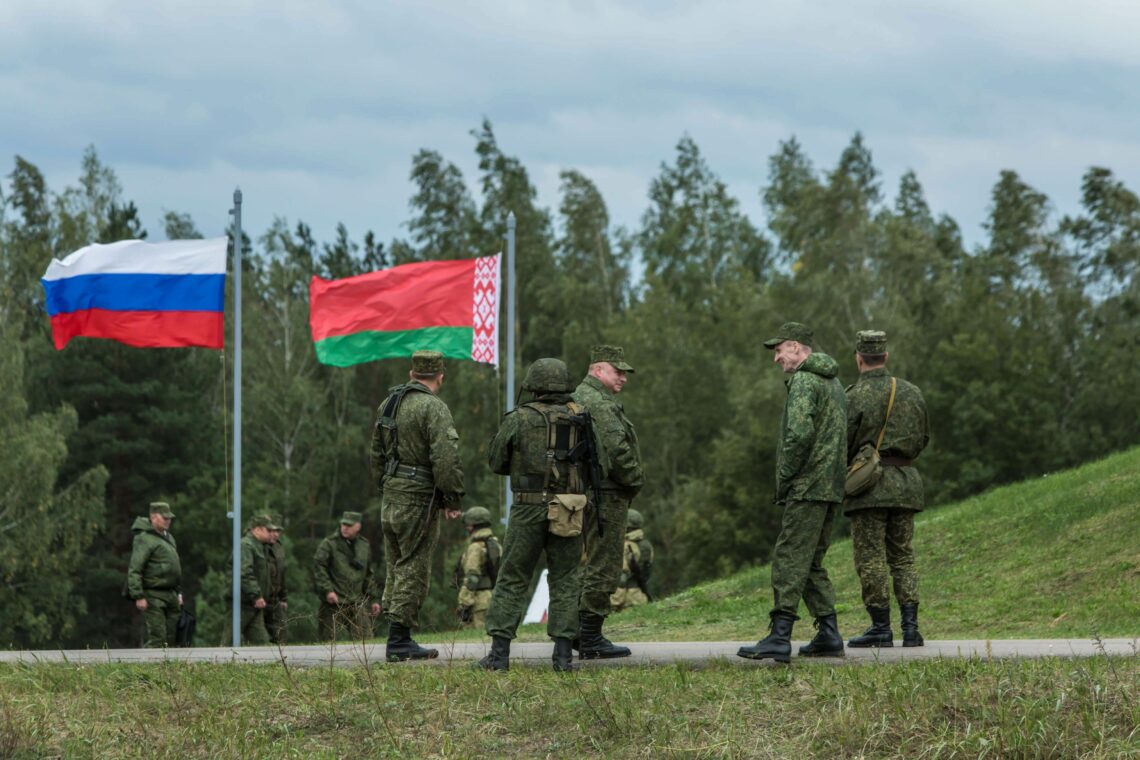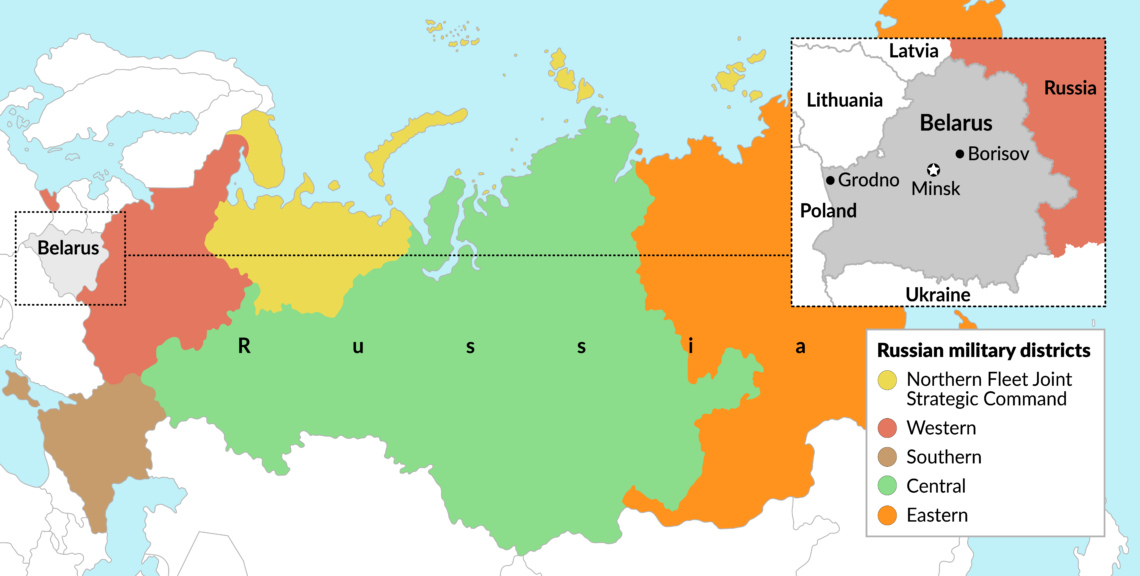Military context of the Belarusian crisis
Russian intervention in Belarus could take many forms: formal assistance granted at the request of the collapsing Lukashenko regime; a stabilization operation amid chaotic conditions, or the armed invasion of a new Belarusian state controlled by the opposition.

In a nutshell
- Russia will not tolerate a pro-Western government in Minsk
- The Russian military intervention in Belarus is strictly a last resort
- The formation of a pro-Russian government is more probable
Belarus occupies a crucial geostrategic position between Russia and NATO countries and plays an important role in the two blocs’ neo-Cold War rivalry. It is a strategic foothold for Russia, potentially allowing it to set up Russian troops only 200 km from the Polish capital, Warsaw.
The 500km-long Belarusian space is also a good shield against NATO threats in the event of Russian entanglement in other strategic regions. Through Kaliningrad, Russia could access the Suwalki Gap, a land corridor that connects Poland with Lithuania and leads to the Baltic countries. Mastering the gap would significantly impede NATO’s ability to support its Baltic allies in an armed conflict.
Geopolitically, Belarus is not an independent player in international security relations but rather a tool for Moscow. Russia is trying to capitalize on this opportunity. On the political front, the Kremlin wants to draw Minsk closer through integration and joint initiatives, mainly through the 1999 Union State Treaty. Belarusian President Aleksander Lukashenko was initially interested in a common state. But when it became clear that Russian President Vladimir Putin planned on staying in power for as long as possible, Mr. Lukashenko lost interest, fearing that this integration would inevitably lead to the absorption of Belarus by Russia.
Belarusian plants produce various components of the weapons systems of the Russian army.
Belarusian society is interested in close cooperation with Russia, but – as public opinion polls show – as an independent state (which 43 percent of respondents favored). It is also worth noting that 18 percent of Belarusian citizens want their country to join the European Union, whereas only 1.4 percent wish for a joint Belarusian-Russian state.
It is mainly through economic dependence, not a political attraction that Russia manages to subjugate Belarus. The Belarusian economy is almost entirely dependent on its eastern neighbor. Most of Belarusian production goes to the Russian market. Belarus is also reliant on Russia for energy – which allows Moscow to blackmail Minsk.
The defense industry of the two countries cooperate closely. Belarus earns around $5 billion per year from this collaboration. Belarusian plants produce various components of the weapons systems of the Russian army. The current strikes at military plants could end up delaying the modernization of the Russian Armed Forces.
Facts & figures

Russified military
Belarus’ military doctrine emphasizes that in the event of aggression, Minsk reserves the right to ask for help, including military assistance, from member states of the Collective Security Treaty Organization and other states in accordance with its international agreements (the Union State Treaty). There is no doubt that a joint Russian-Belarusian operational strategy exists in the event of a war.
The armed forces of Belarus are very much Russified. They consist of about 50,000 soldiers, land forces (four mechanized brigades armed with, among others, T-72 battle tanks and BMP-2 infantry fighting vehicles), air force and antiaircraft defense (with MIG fighters and SU assault aircraft, S-300 long rage surface-to-air missile system) and rapid response units (air assault, airborne and special operations brigades). The forces are subordinate to two operational commands: Borisov in the north and Grodno in the west. The training programs, combat regulations, and practical training are almost identical in both armies. Senior cadres of the Belarusian military are educated at Russian universities. Most weapons are manufactured in Russia or post-Soviet states.
This advanced military integration is a crucial factor when analyzing potential developments. In the event of a conflict, Russia aims to ensure that the entire Belarusian army will operate according to Moscow’s plan, jointly with the Russian troops of the Western Military District. Russia is attempting to include the Russian-Belarusian forces in the command chain of this district. However, Belarus balks at this, not wanting to be completely incapacitated with regard to its armed forces. In recent years, Russia has made multiple political, economic and military efforts to be allowed to deploy its air force bases in Belarus, but to no avail.
The secret services of Russia and Belarus also cooperate in their intelligence activities against NATO and their efforts to fight organized crime and terrorism. It can be assumed that the Russian secret services greatly influence all segments of the Belarusian state structure, perhaps even more so than in Ukraine.
Scenarios
Scenarios of Russian intervention
Three scenarios could take place: an armed Russian intervention and the full subordination of Belarus to Russia; a violent pacification of the protests by the current regime and the postponement of an inevitable political breakthrough; or a power takeover by the opposition.
Depending on the events, a Russian intervention could take different forms: formal assistance granted at the request of the collapsing Lukashenko regime; a stabilization operation amid chaotic conditions; or the armed invasion of a new Belarusian state led by the opposition. All those options would entail substantial economic and political costs for Russia
The least risky course of events from Moscow’s standpoint would be the first. The third would prove riskiest, but at the same time necessary because of Russian strategic interests.
If Russian assistance is requested, it would be granted as an operation based on the Supreme Council of the Union State’s decision and prepared under cover of joint Russian-Belarusian maneuvers. For example, accelerated strategic exercises (which are planned to take place next year) in response to alleged external threats.
On the Russian side, air-assault and airborne troops and the Western Military District units would undoubtedly be used. Some of them would operate with the Belarusian army units within the joint Regional Army Group of the Union State. In the event of the violent pacification of protests, Moscow would probably try to frame the intervention as a stabilization mission for the Collective Security Treaty Organization.
An open Russian military invasion of a neighboring country would be politically costly. Therefore, it can be expected that Russia will do everything not to find itself in such a position, possibly intervening in advance if necessary.
The nature and course of a Russian military intervention would depend on the reaction of the Belarusian army. If an intervention is requested, full cooperation with the Russians can be expected. In this case, the Belarusian military would become the backbone of the government in Minsk. Belarus would lose any remaining political independence, and Russian military bases would be established on its territory, not only the air force that Russia has so far sought but also land forces.
In a stabilization operation amid civil war, the Belarusian army would likely act more chaotically. Some soldiers would be on one side and some on the other. It is possible that this could even apply to entire units of the Belarusian army. The Russian “stabilization forces” would try to take advantage of the pro-Russian cadres of the Belarusian army and co-opt as many of them as possible. As a result, Belarus could become a fictional state similar to Abkhazia and South Ossetia.
The military invasion of a pro-Western, “post-Lukashenko” Belarus would be the worst outcome for all. The final political effect would probably be the incorporation of Belarus into the Russian Federation, like Crimea. But such aggression would entail armed clashes with the Belarusian forces and civilian resistance. These developments would shock not only the international community but also significant segments of the Russian population.
In any case, the West would have to react. However, this reaction is likely to be diplomatic, legal or economic. A direct counter-intervention is highly improbable. However, since the Russian invasion would worsen the security conditions on NATO’s eastern front, it would probably entail an increase in the alliance’s presence in the region. The planned reduction of United States troops in Europe could very well be put on hold. A second cold war in Europe would further develop.
Scenarios of internal resolution
Russia will only intervene as a last resort. Therefore, an internal resolution or a forceful pacification by the Belarusian armed forces are more likely.
The Belarusian army is being prepared for this in a variety of hybrid exercises. Mr. Lukashenko will be able to count on at least temporary political and economic support from President Putin, as well as camouflaged help from the Russian army and special forces (including the famous “little green men” seen in Ukraine). President Lukashenko’s position would be significantly weakened, both in Belarusian society and vis-a-vis Russia.
As a result, Russia would have the opportunity to strengthen Russian-Belarusian integration, including the creation of the military bases in Belarus. The West would probably remain neutral, perhaps only carrying out additional military maneuvers in Poland and the Baltic states as part of the neo-Cold War.
Even a forceful pacification would not permanently crush the hopes of the Belarusian nation. This wave of political emancipation is no longer reversible. Political change may, therefore, be the likeliest option. But a Lukashenko removal does not necessarily equal a pro-Western Belarus. The majority of society is pro-Russian and the opposition does not show strong anti-Russian tendencies either. Moreover, Russia will be able to influence the formation of the new government, like in Armenia two years ago.
In these circumstances, the military would play an essential role by ensuring a peaceful transition. But in this scenario, too, Belarus would be threatened with Russian intervention should the new authorities try to adopt a pro-Western course – a threat of a much greater scale than in the case of Ukraine in 2014.








